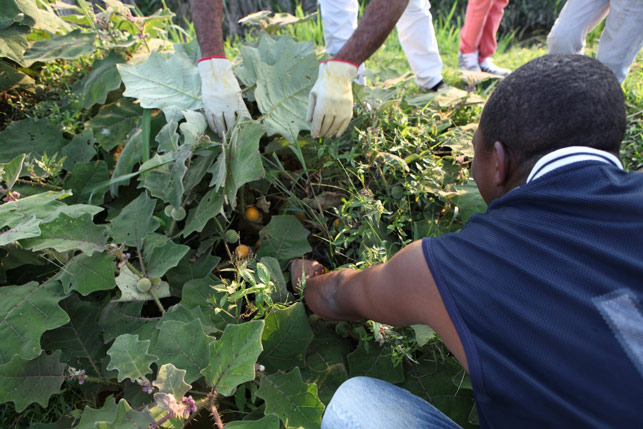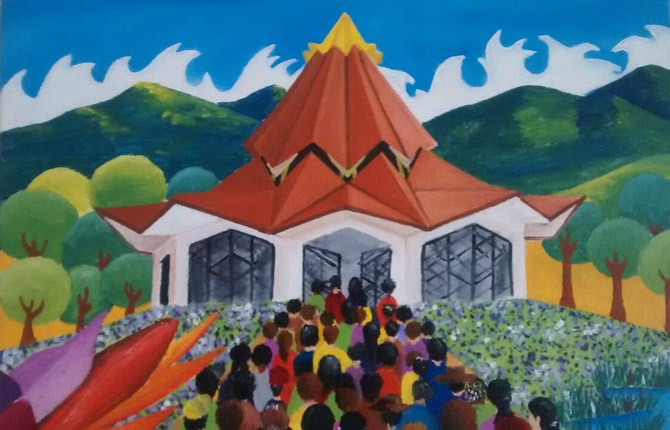O thou seeker after truth! The world of the Kingdom is one world. The only difference is that spring returneth over and over again, and setteth up a great new commotion throughout all created things. Then plain and hillside come alive, and trees turn delicately green, and leaves, blossoms and fruits come forth in beauty, infinite and tender. – Abdu’l-Baha, Selections from the Writings of Abdu’l-Baha, p. 58.
In Norte del Cauca, the land is blanketed by sugar cane plantations. They run for miles, under the watchful gaze of the Andes.
Scattered amid the expanse of monoculture fields, villages and small farms dot the terrain. In recent decades, these traditional farms and the lush greenery of the region have been largely overtaken by vast fields of sugar cane crop.

Here, in the village of Agua Azul, and in neighboring communities, people have been talking about the revival of the natural habitat. This conversation was catalyzed in April 2012, when it was announced that a Baha’i House of Worship was to be built here for the people of the region.
Over the period since the announcement, as the community has set out to prepare itself for this momentous development, a heightened consciousness of the nature and purpose of the House of Worship has given rise to an acute awareness about the physical environment and its relationship to the spiritual and social well-being of the population.
“There were several meetings early on, when plans for the Temple were announced,” explains Ximena Osorio, a representative of the Colombian Baha’i community. “People were inspired by the concept of the House of Worship, how it brought together devotion and service, how it was to be a place of worship for everyone.”
“Gradually, conversations arose about the types of trees and flowers that would surround the Temple,” says Ms. Osorio. “They wanted the landscape to capture the beauty and diversity of the region.”
Over time, the conversation evolved. “An idea emerged,” continues Ms. Osorio. “We would grow a native forest on the land surrounding the Temple site.”
The idea took root, and a team coalesced around the project.
Hernan Zapata, affectionately referred to within the community as “Don Hernan”, recently joined the initiative. A traditional farmer from the neighboring village of Mingo, he has worked the land his entire life.
Today, his is one of the remaining traditional farms in the region, and many of the species which are found on his land have all but disappeared in surrounding areas. His land provides a glimpse into the rich ecological diversity that had characterized Norte del Cauca only decades ago.
“The truth is that Norte del Cauca was once an immense forest,” explains Don Hernan. “But all of that has been destroyed. Now none of it exists.”
“One thing I want with this project,” he explains, “is that new generations should know what once existed. This native forest that we are going to grow should be a school, should be a place of learning.”

The project has captured the imagination of many others in the region as well. Throughout neighboring villages, individuals have begun to donate seeds and plants that can be grown on the land around the Temple site and in a greenhouse that has been built for the project by local volunteers.
Contributions have included indigenous species, such as the rare “Burilico” tree, which is near extinction in the region.
For Gilberto Valencia, a local factory worker and member of the project team, this initiative has connected him to his family history in Norte del Cauca.
“I’ve always been very motivated to know more about the land and about farming because, while I am not a farmer, I come from a long line of farmers. My father and his father always had a farm that they cultivated for the subsistence of the family, and for the sale of goods to others.”
The project inspired Mr. Valencia, who is married and a father, to begin studying environmental engineering.
“When I began working on the land surrounding the House of Worship, I felt at that moment, that the thing that we were going to build was going to change the natural environment,” he said. “This is a chance to change the destiny of the region.”
Mr. Valencia now works on the project alongside his ten year old son, Jason, the project team’s newest and youngest member.
In recent months, Jason has found himself immersed in the project, helping to transplant seeds and saplings to the temple site and working alongside his father to cultivate and protect the surrounding land.
“I have learned about trees I never knew existed,” says Jason, speaking about his experience. “I love working with my father on this project because, together, we’re going to revive many of the plants that have been lost.”
For Alex Hernan Alvarez, a resident of Agua Azul and member of the project team, what is happening in the village has profound implications for the children.

“Here, in Norte del Cauca, we don’t have land or spaces like this, open for everyone. I have three children, and it is very gratifying for me to think that I will leave something for them,” says Mr. Alvarez.
“Knowing that a verdant forest and magnificent House of Worship will bloom for future generations inspires in me a profound sense of dedication.”
Speaking of one of the indigenous trees of the region – the ’Saman’ tree – Mr. Alvarez states, “The Saman is a traditional tree, beautiful and large. When my children go to the land to pray, they will have a place to sit, under that tree. This motivates me every day. This brings me joy.”
While the House of Worship is not yet built, in many important ways, it is already carrying out its purpose, inspiring the inhabitants of the region to connect with the sacred and reach for greater heights of service to their communities.
“The idea of the Temple, what it represents,” says Ms. Osorio, “is in itself cultivating in all of us – children, youth, and adults – an appreciation for the importance of a life centered around worship of God and service to humanity.”

















Comments
Sign in or create an account
Continue with Facebookor